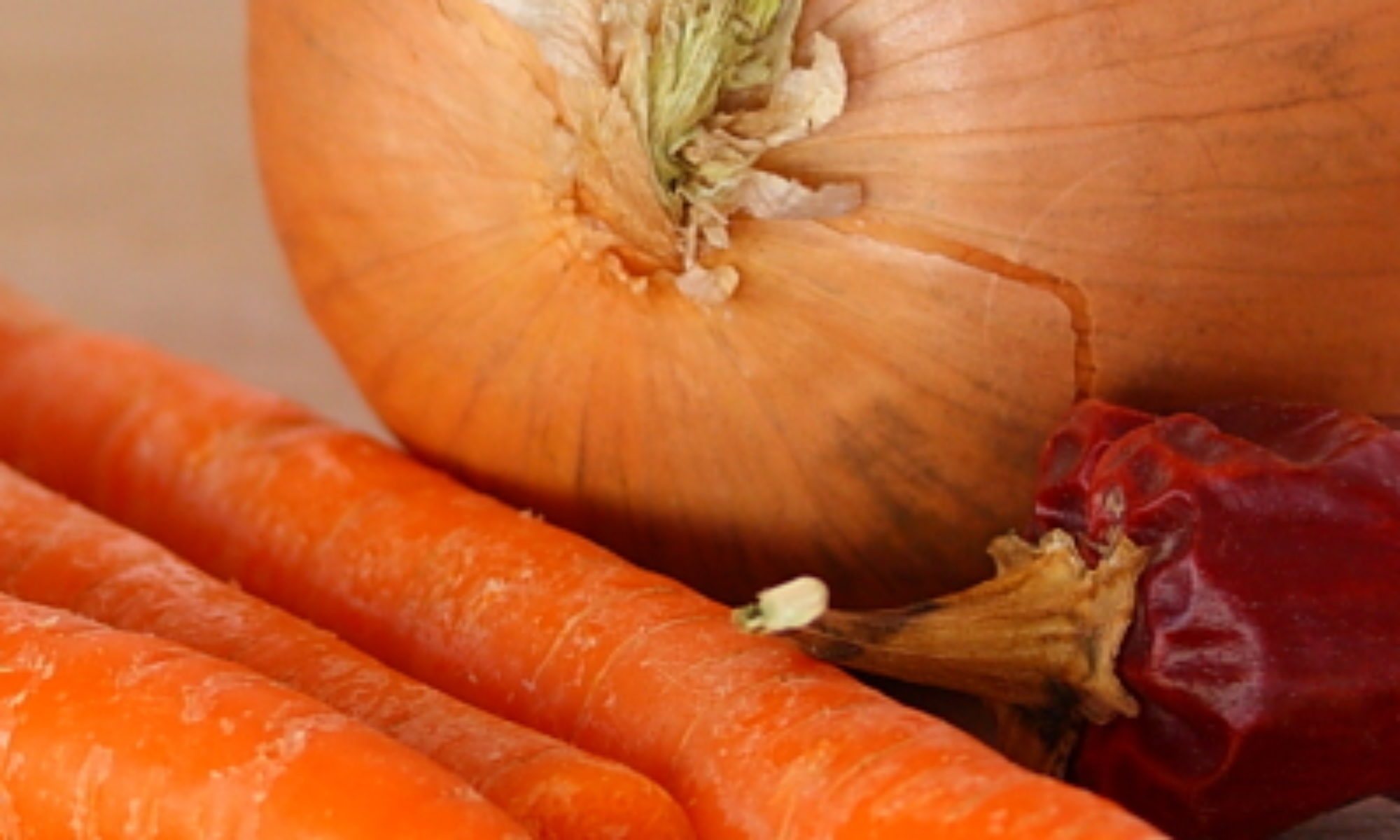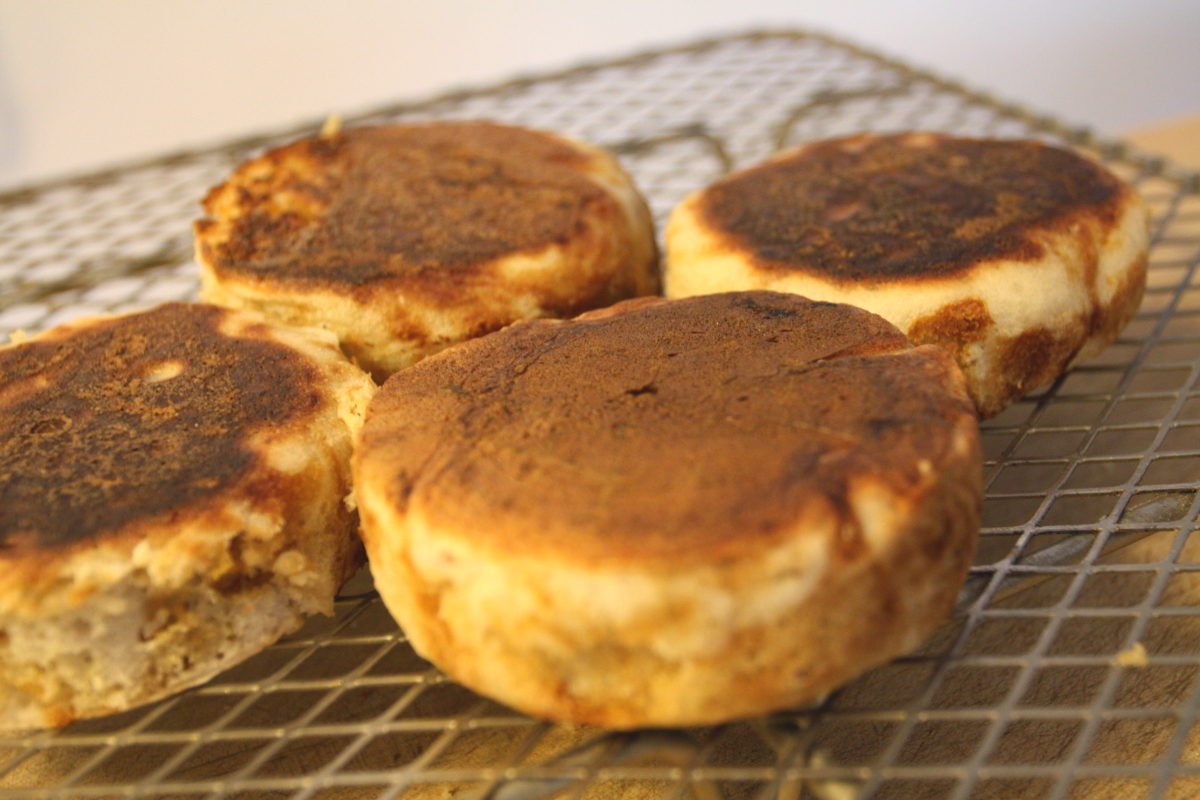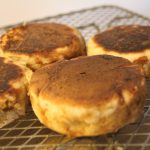
We think that regular readers know that we make bread once a week, and have been doing so for a number of years, mainly because bread from the store is down-right awful. And that should not be taken as thinking we’re full of awe at store-bought bread. Well, what to do when we use up the week’s bread early? Or, just as with the other week, bring it to an event, leaving us lacking in the bread department?Most times, we just make up the next batch of bread early and we’re good to go. But lately, we’ve been craving an English muffin. We’ve tried making these in the past, but didn’t have great success. Which, apparently is common (there’s a burger place in town that makes its own English muffins and brands them; they’re less than stunning), so we’re in good company. But, recently, we came across this post which seemed to answer the call. She seemed to know exactly what we were looking for in an English muffin, which is what everyone wants, but the recipes we tried don’t deliver: nooks and crannies! We can just hear the outcry from our scratchers, “What do we want? Nooks and Crannies! When do we want them? Now!”
Our readers are strident.
Oh, and to let people know, we changed the recipe a bit to match some standard baking techniques, and to use ingredients we had on hand (why use milk powder and water, when you can just use milk?).
English Muffins
Ingredients
- 1/3 cup warm water 110°F
- 2 tsp dried yeast
- 1/4 tsp sugar
- 1 cup milk
- 1 Tbs butter
- 1 Tbs sugar
- 1/2 tsp kosher salt
- 250 g all-purpose flour (1 3/4 cups)
- 1/2 tsp kosher salt
- 1/2 tsp baking soda
Instructions
- In a small bowl, combine warm water, yeast and 1/4 tsp sugar. Stir until dissolved. Let sit 10 minutes until foamy.
- In a large mixing bowl, combine milk and butter. Place in microwave and heat until milk is warm and butter is melted, about 3 minutes.
- Add sugar and salt to milk and stir to dissolve. Add flour and stir to form a batter.
- Add yeast mixture and stir into batter. Beat batter well. Cover and let rise until doubled in size, about 30 minutes. Meanwhile, preheat lightly greased griddle over low heat and grease 3x1 inch tart rings.
- Stir additional salt and baking soda into batter.
- Place rings on griddle and fill 3/4 of the way with batter. Cover and cook 5 minutes. Turn over, cover, and cook an additional 5 minutes. Remove from griddle and let cool completely.
Ingredient discussion:
As we alluded to above, the original recipe called for milk powder to be added to hot water. We thought that it made more sense just to use milk. We used organic fat-free milk, but it should work with any milk. Butter, unsalted, of course. In this recipe, you definitely don’t want too much salt up front, as it will retard the action of the yeast, meaning your batter won’t rise fast enough. That’s also the reason some of the salt is added right before cooking. The baking soda will help make the bubbles in the batter while cooking, but we found that it left a slightly salty taste, too. So, we cut the amount in half from the original. While we haven’t tried it, baking powder might be a better choice, as it’s designed to activate and bubble when heated (that’s the second half of “double-acting”; the first is when it’s mixed).
Procedure in detail:
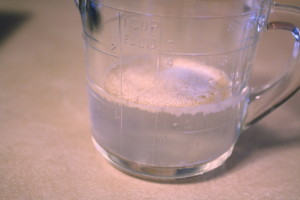
Proof yeast. We, and you, by proxy, want to get that yeast working, and working hard. These little fungi are going to do a lot of heavy lifting in a short time, so let’s get them primed for work by mixing together the warm water, yeast, and that 1/4 tsp of sugar. The water needs to be warm to the touch; too hot, and the yeast will die; too cool, and they’ll have a hard time activating. So, take a tip from baby bear and get it just right. The sugar will give the yeast some food and get them rarin’ to go. Let it sit about 10 minutes.
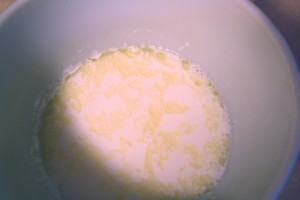
Heat milk and butter. We figured the easiest way would be to put the milk and butter into a large mixing bowl, and just heat it up in the microwave. We heated it in 60- second increments, until the butter melted and the milk felt quite warm — warmer than the water in the previous step.
Dissolve sugar and salt. Add the sugar and salt to the milk mixture and stir until dissolved.
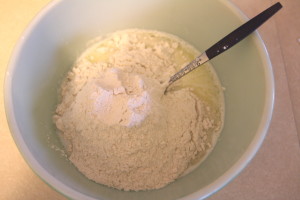
Add flour. Add the flour to the milk mixture and stir it in thoroughly. At this stage, you really can’t over-mix, as you don’t want any lumps. The batter should be still warm, but no longer hot.
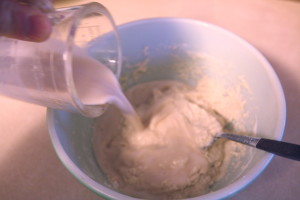
Add yeast. That yeast mixture should be all foamy, which means the yeast is ready for action. Add it to the batter and stir it in thoroughly. In fact, beat the batter with a spoon for about a minute.
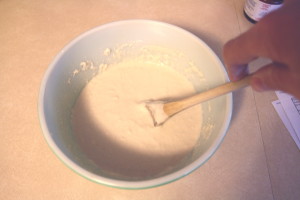
Rest. Cover the batter and let it rest for about 30 minutes. It will rise and at least double in size. Ours seemed to triple in size.
Preheat griddle. While the batter is rising, start preheating the griddle over low heat. Put a light coating of shortening on the surface, and grease up the tart rings (if you don’t have tart rings, you can just scoop batter onto the griddle and make rustic-shaped muffins). This is the tricky part of making English muffins — getting that griddle just the right temperature, so that they’ll cook all the way through without burning the outsides. Regardless of what we tell you, you’ll have to experiment and find what works for you. And expect a few extra-dark muffins until you get it all figured out.
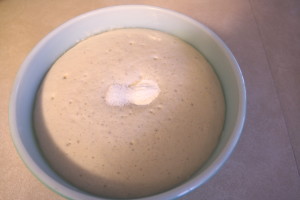
Add salt and baking soda. The batter has risen, so stir in the salt and baking soda, and you’re ready to make muffins; well, technically crumpets.
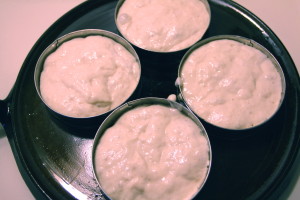
Griddle. Place the tart rings on the griddle and fill each 3/4 full. You can sprinkle a bit of cornmeal before adding the batter to give it a more authentic look; we did for some, and not for others. Once the tart rings have batter in them, cover with a large skillet lid and let cook for about 5 minutes. Turn over, cover again, and cook about 5 minutes more. Again, here’s where practice will come in handy. After awhile, you’ll find the right temperature and time combination to make perfect muffins. Expect a few “clunkers” at first.
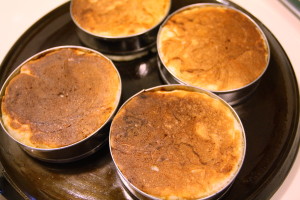
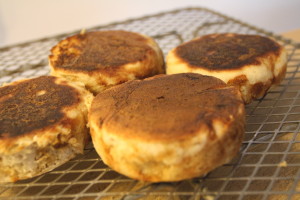
Let cool completely. If you need to, you can try to remove those tart rings, but be careful, they’re hot. Ask us how we know. You don’t have to ask, do you? Once cool, split open, toast, and enjoy.
This is the first English muffin recipe that came close to what we think of as English muffins. Others that we’ve tried were too much like bread — good, but not enough nooks and crannies — or even worse, too doughy — can you say raw middles? As with anything good, we’re still working on perfecting the cooking technique: where to set the burner dial, how much batter, and how long too cook. But, right from the get-go, these were remarkably like English muffins. Enough so, to warrant four stars. (They would be five, but they’re tricky to cook just right).
